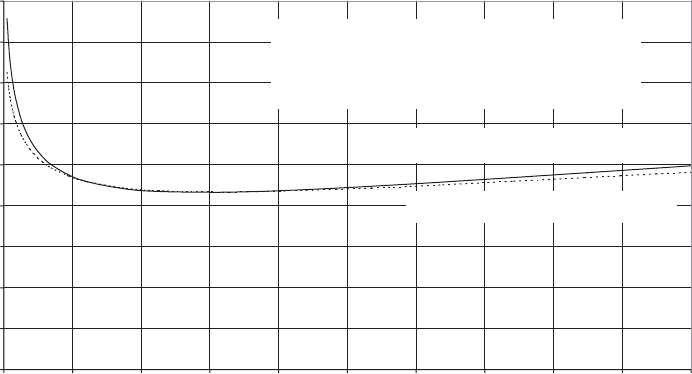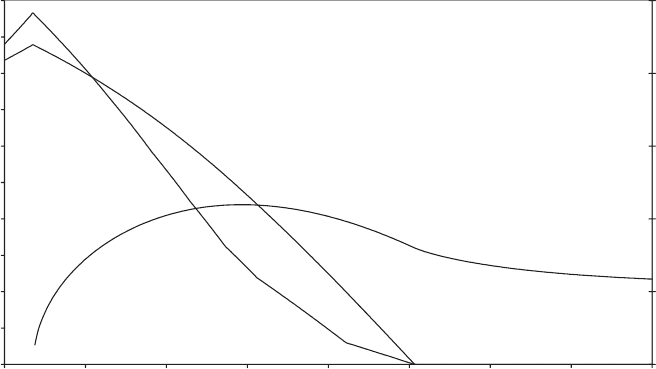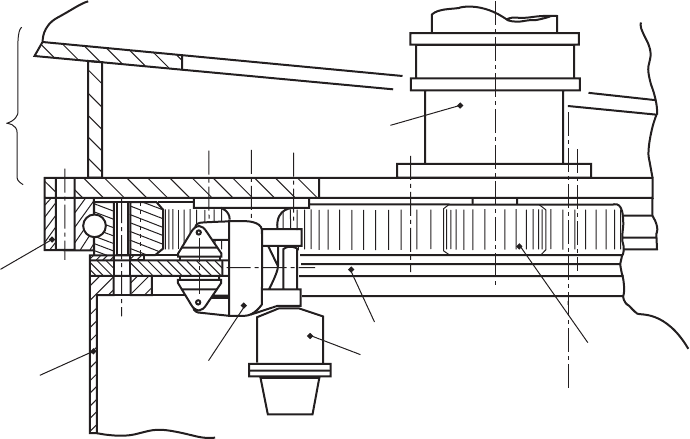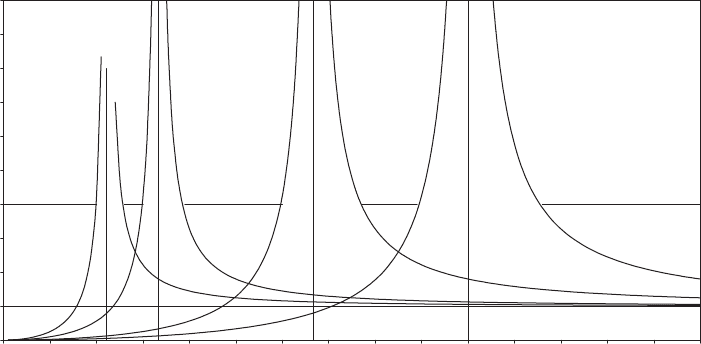Burton T. (et. al.) Wind energy Handbook
Подождите немного. Документ загружается.


brake disc. The rate of energy dissipation is equal to the product of the braking
torque and the disc rotational speed, so in the latter stages of braking the rate of
energy dissipation cannot sustain the high surface temperatures and they begin to
fall again.
The coefficient of frict ion for pads of resin-based materials is sensibly constant at
a level of about 0.4 at temperatures up to 2508C, but begins to drop thereafter,
reaching 0.25 at 4008C. Although in theory the brake can be designed to reach the
latter temperature, in practice the varying torque complicates the calculations and
leaves little margin of error against a runaway loss of brake torque. Accordingly
3008C is often taken as the upper temperature limit for resin-based pads.
Sintered metal pads have a constant coefficient of friction of about 0.4 up to a
temperature of at least 4008C, but manufacturers indicate that the material can
perform satisfactorily at temperatures up to 6008C on a routine basis, or up to 8508
intermittently. Wilson (1990) reports a reduced friction coefficient of 0.33 at 7508C.
Such temperatures cannot be realized in practice because the temperature of the
disc itself is limited to 6008C in the case of spheroidal graphite cast iron or to a
much smaller value in the case of steel (op. cit.).
Clearly the use of the more expensive sintered brake pads allows the brake disc
to absorb much more energy. Howeve r, the sintered metal is a much more effective
conductor of heat than resin-based material, so it is often necessary to incorporate
heat insulation into the calliper design to prevent overheating of the oil in the
hydraulic cylinder. A method of calculating brake-disc temperature rise is given in
the next section.
7.6.3 Calculation of brake disc temperature rise
The build up in tempe rature across the width of a brake disc over the duration of
the stop can be calculated quite easily if a number of assumptions are made. First,
the heat generated is assumed to be fed into the disc at a uniform intensity over the
areas swept out by the brake pads as the disc rotates. This is a reasonable
approximation for a high-speed shaft-mounted brake and for a low-speed shaft-
mounted brake with several callipers until rotation has almost ceased, but the
energy input by this stage is much lower. Within the disc heat flow is assumed to
be perpendicular to the disc faces only, i.e., radial flows are ignored.
Consider a brake-disc slice at a distance x from the nearest braking surface, of
thickness ˜x and cross-sectional area A. The rate of heat flow away from the nearest
braking surface ente ring the slice is
_
QQ ¼kA(d Ł=dx) (where Ł is the temperature
and k the thermal conductivity) and the rate of heat flow leaving it on the far side is
_
QQ þ (d
_
QQ=dx). The temperature rise of an element of thickness ˜x over a time
interval ˜ t is given by
˜ŁA˜xrC
p
¼ ˜Q ¼
d
_
QQ
dx
˜x˜t ¼ kA
d
2
Ł
dx
2
˜x˜ t
where r is the density and C
p
is the specific heat, so that
MECHANICAL BRAKE 445

dŁ
dt
¼
k
rC
p
d
2
Ł
dx
2
(7:59)
Adopting a finite-element approach, Equation (7.59) can be written
Ł(x, t þ ˜ t) ¼ Ł(x, t) þ
k
rC
p
˜t
(˜x)
2
[Ł(x þ ˜x, t) þ Ł(x ˜x, t) 2Ł(x , t)] (7:60)
Substituting values of k ¼ 36 W=m per 8K, C
p
¼ 502 J=kg per 8K and r ¼
7085 kg=m
3
for Grade 450 spheroidal graphite cast iron yields a value for the
thermal diffusivity Æ ¼ k=(rC
p
)of1:01 3 10
5
m
2
=s. If the time increment, ˜t,is
selected at 0.025 s and the element thickness is taken as 1.005 mm, then Equation
(7.60) simplifies to
Ł(x, t þ ˜t) ¼ 0:25[Ł(x þ ˜x, t) þ Ł(x ˜x, t) þ 2Ł(x, t)] (7:61)
This equation can be used to calculate the temperature distribution across the brake
disc, starting with a uniform distribution and imposing suitable increments at the
braking surfaces at the boundaries. The behaviour at the boundaries is simpler to
follow through if they are treated as planes of symmetry like the disc mid-plane,
with imagined discs flanking the real one. The temperature increment at the
boundary at each time step, which is added to that calculated from Equation (7.61),
is given by
˜Ł
0
¼
2Tø(t)˜t
rC
p
S
(7:62)
where T is the braking torque (assumed constant), ø(t) is the disc rotational speed
at time t, and S is the area swept out by the brake pad (or pads) on one side of the
disc. For a disc diameter D and pad width w, S is (D w)w. The factor 2 is
required because heat is assumed to flow into the imagined disc as well as into the
real one. Hence the initial temperature build up can be calculated as illustrated in
Table 7.6, taking an arbitrary value of ˜Ł
0
of 408C. (The gradual reduction in ˜Ł
0
over time due to deceleration is ignored here for simplicity.)
The brake-disc surface temperature rise is found to be a minimum when the ratio
of the braking torque to the maximum aerodynamic torque is about 1.6. As the ratio
is reduced below this value, the exte nded stopping time results in more ene rgy
being abstracted from the wind, so temperatur es begin to rise rapidly. On the other
hand, the maximum brake temperature is relatively insensitive to increases in the
ratio above 1.6. The variation in maximum brake-disc surface temperature with
braking torque is illustrated for the emergency braking of a stall-regulated machine
following an overspeed in Figure 7.35, where the continuous line gives the surface
temperature rise calculated by the finite-element method outlined above. It tran-
spires that the maximum temperature rise can be estimated quite accurately by the
following empirical formula
446 COMPONENT DESIGN

Ł
max
Ł
0
¼
E
ffiffi
t
p
1
64 600w(D w)
¼
E
ffiffi
t
p
2
64 600S
(7:63)
where E is the total energy dissipated in Joules, t is the duration of the stop in
seconds and S is the area of the disc surfaces swept by the brake pads. The
temperature derived using this formula is plotted as a dotted line in Figure 7.35 for
comparison.
7.6.4 High-speed shaft brake design
A key parameter to be chosen in brake design is the design braking torque. The
coefficient of friction can vary substantially above and below the design value due
to such factors as bedding in of the brake pads and contamination, so the desi gn
braking torque calculated on the nominal friction va lue must be increased by a
suitable mate rials factor. Germanisch er Lloyd specify a materials factor of 1.2 for
the coefficient of friction, and add in another factor of 1.1 for possible loss of calliper
spring force. If these factors are adopted, the minimum design braki ng moment is
1.78 times the maximum aerodynamic torque, after including the aerodynamic load
factor of 1.35. A small additional margin of, say, 5 percent should be added to
Table 7.6 Illustrative Example of Calculation of Brake Disc Temperature Rise Using Finite
Element Model
Time Time Element 0 1 2345
step (s) Distance from braking
surface (mm)
0 1.0 2.0 3.0 4.0 5.0
1 Initial temperature 0 0 0000
Boundary temperature
increment
40
0.025 Temperature at end of time
step
20100000
2 Boundary temperature
increment
40
Sum 60100000
0.05 Temperature at end of time
step
35 20 2.5 0 0 0
3 Boundary temperature
increment
40
Sum 75 20 2.5 0 0 0
0.075 Temperature at end of time
step
47.5 29.4 6.3 0.6 0 0
4 Boundary temperature
increment
40
Sum 87.5 29.4 6.3 0.6 0 0
0.1 Temperature at end of time
step
58.5 38.2 10.6 1.9 0.1 0
MECHANICAL BRAKE 447

ensure that the rotor is still brought to rest without a very large temperature rise
should the 1.78 safety factor be completely eroded.
The procedure to be followed for the design of a brake on the high-speed shaft
(HSS) can conveniently be illustrated by an example.
Example 7.1: Design a HSS brake for a 60 m diameter, 1.3 MW stall-regulated
machine capable of shutting the machine down in a 20 m/s wind from a 10 percent
overspeed occurring after a grid loss, with or without assistance from the aero-
dynamic braking system. The nominal LSS and HSS rotational speeds are 19 r.p.m.
and 1500 r.p.m. respectively, ignoring generator slip. Assume that the brake
application delay time is 0.35 s, and that the inertia of the turbine rotor, drive train ,
brake disc and generator rotor – all referred to the low-speed shaft – totals
2873 Tm
2
.
(a) Derivation of the brake design torque: The peak aerodynamic torque occurs when
the maximum rotational speed is reached just prior to brake application. The
first step is to determine the relationship between rotational speed and
aerodynamic torque for the stated wind speed of 20 m/s. From this the
acceleration of the rotor and build-up of aerodynamic torque during the 0.35 s
delay before the brake comes on can be determined. The speed increase in this
case is 1 r.p.m., giving a maximum rotor speed of 19 3 1:1 þ 1 ¼ 21:9r:p:m:
and peak aerodynamic torque of 966 kNm. Hence the brake design torque is
966 3 1:78 3 1: 05 ¼ 1800 kNm referred to the low-speed shaft, or 1800 3
19=1500 ¼ 22:8 kNm at the brake.
0
100
200
300
400
500
600
700
800
900
1 1.2 1.4 1.6 1.8 2 2.2 2.4 2.6 2.8 3
Ratio of braking torque to maximum aerodynamic torque
Temperature rise (⬚ C)
Maximum temperature rise calculated from FE analysis
- continuous line
Maximum temperature rise calculated from formula
E/(t
0.5
) x 1/(64600w(D-w)) - dotted line
Nominal rotational speed = 19 r.p.m.
Delay in brake operation = 0.35 s
Maximum aerodynamic torque = 966 kNm
Disc diameter = 1.0 m, Pad width = 0.22 m
Figure 7.35 Brake Disc Surface Maximum Temperature Rise for Emergency Braking of 60 m
Diameter 1.3 MW Stall-regulated Turbine from 10 percent Overspeed in 20 m/s Wind with
HSS Brake Acting Alone
448
COMPONENT DESIGN

(b) Brake-disc diameter selection: The maximum rotor speed corresponds to a high-
speed shaft spee d of 21:9 3 (1500=19) ¼ 1729 r:p: m: ¼ 181 rad=s, so the maxi-
mum permissible brake-disc radius as regards centrifugal stresses is about
90=181 ¼ 0:497 m. It is advisable to choose the largest permitted size in order
to minimize temperature rise, so 1.0 m diameter is selected in this case. The
pad rubbing speed will be quite acceptable if sintered pads are used.
(c) Selection of number and size of brake pads: The total brake-pad area is governed by
the need to keep the maximum power dissipation per unit pad area below
11.6 MW/m
2
. The power dissipation is equal to the product of the braking
torque and the rotational speed, so it is at a maximum at the onset of braking,
i.e. 22:8 3 181 ¼ 4128 kW, giving a required total area of the brake pads of
4128=11 600 ¼ 0:356 m
2
. This area can be provided by four callipers fitted with
0:22 3 0:22 m pads, giving 0.387 m
2
in all.
(d) Maximum brake-disc temperature check: The variation in disc surface temperature
over the duration of the stop can be calculated using the finite-element method
outlined in the preceding section. The resulting variation in this case is plotted
in Figure 7.36. The surface temperature reaches a maximum of 4408C, just after
halfway through the stop, which lasts 4.7 s from the time the brake comes on.
This temperature is well below the limit for sintered pads.
(e) Calliper force: The braking frict ion force require d is 58.5 kN, calculated from the
torque divided by the effective pad radius of 0.39 m. Hence the required
calliper force is 58:5=(8 3 0:4) ¼ 17:3 kN which is rather low for a calliper sized
for a 0:22 3 0:22 m brake pad.
0
100
200
300
400
500
600
700
800
900
1000
012345678
Time (s)
Torque (kNm) and temperature rise (⬚ C)
0
5
10
15
20
25
Rotational speed (r.p.m.)
Rotational speed
Disc surface
temperature rise
Aerodynamic torque
Nominal rotational speed = 19 r.p.m.
Rated power = 1.3 MW
Delay in brake application = 0.35 s
Brake torque referred to LSS = 1800 kNm
Maximum aerodynamic torque = 966 kNm
Disc diameter = 1.0 m, No. of callipers = 4
Pad dimensions = 0.22 x 0.22 m
Figure 7.36 Emergency Braking of Stall-regulated 60 m Diameter Turbine from 10 percent
Overspeed in 20 m/s Wind with HSS Mechanical Brake Acting Alone
MECHANICAL BRAKE 449
The design process outlined above results in an excessive number of lightly-
loaded callipers, because of the limitation on power dissipation per unit area. If the
relative infrequency of emergency braking events allowed this limitation to be
relaxed, then a more economic solution would result.
7.6.5 Two level braking
During normal as opposed to emergency shut-downs, the rotor is decelerated to a
much lower speed by aerodynamic braking before the brake is applied, so the brake
torque required is much reduced. In view of the benefit of reduced loads on the
braking system, and on the gearbox in particular, some manufacturers arrange for a
reduced braking torque for normal shut-downs. This is achieved on the usual
‘spring applied, hydraulically released’ brake callipers by allowing oil to discharge
from the hydraulic cylinder via a pressure relief valve when the brake is applied, so
that the hydraulic pressure drops to a reduced level. After the rotor has come to
rest, the remaining hydraulic pressure can be released, so that the brake torque rises
to the full level.
7.6.6 Low-speed shaft brake design
The procedure for designing a low-speed shaft disc brake is much simpler than that
for the high-speed shaft brake, because the limits on disc-rim speed, pad-rubbing
speed, power dissipation per unit area and temperature rise do not influence the
design, which is solely torque driven. The large braking torque required means that
a brake placed on the low-speed shaft will be much bulkier than one with the same
duty placed on the low-speed shaft. For example the design LSS braking torque of
1800 kNm from the example above would require a 1.8 m diameter disc fitted with
seven callipers.
A study by Corbet, Brown and Jamieson (1993), which investigated a range of
machine diameters, concluded that the brake cost would double or treble if the
brake were placed on the low-speed shaft rather than on the high-speed shaft.
However, when the extra gearbox costs associated with a high-speed brake were
taken into account, the cost advantage of the high- speed shaft brake disappeared.
7.7 Nacelle Bedplate
The functions of the nacelle bedplate are to trans fer the rotor loadings to the yaw
bearing and to provide mountings for the gearbox and generator. Normally it is a
separate entity, although in machines with an integrated gearbox, the gearbox
casing and the nacelle bedplate could, in principle, be a single unit. The bedplate
can either be a welded fabrication consisting of longitudinal and transverse beam
members or a casting sculpted to fit the desired load paths more precisely. One
fairly common arrangemen t is a casting in the form of an inverted frustum which
450 COMPONENT DESIGN

supports the low-speed shaft main bearing at the front and the port and starboard
gearbox supports towards the rear, with the generator mounted on a fabricated
platform projecting to the rear and attached to the main casting by bolts.
Although conventional methods of analysis can be used to design the bedplate
for extreme loads, the complicated shape renders a finite-element analysis essential
for calculating the stress concentration effects needed for fatigue design. Fatigue
analysis is complicated by the need to take into account up to six rotor load
components. However, given stress distributions for each load component obtained
by separate FE analyses, the stress-time history at any point can be obtained by
combining appropriately scaled load component time histories previously obtained
from a load case simulation.
7.8 Yaw Drive
The yaw drive is the name given to the mechanism used to rotate the nacelle with
respect to the tower on its slewing bearing, in order to keep the turbine facing into
the wind and to unwind the power and other cables wh en they become excessively
twisted. It usually consists of an electric or hydraulic motor mounted on the nacelle,
which drives a pinion mounted on a vertical shaft via a reducing gearbox. The
pinion engages with gear teet h on the fixed slewing ring bolted to the tower, as
shown in Figure 7.37. These gear teeth can either be on the inside or the outside of
the tower, depending on the bearing arrangement, but they are generally located on
the outside on smaller machines so that the gear does not present a safety hazard in
the restricted space available for personnel access.
Nacelle
bedplate
Yaw
bearing
(with internal
gear)
Tower
wall
Calliper
yaw brake
Brake disc
Hydraulic
thruster
Tower
Yaw drive
pinion
Yaw drive
gearbox
C
L
Figure 7.37 Typical Arrangement of Yaw Bearing, Yaw Drive and Yaw Brake
YAW DRIVE 451

The yaw moments on rigid hub machines arise from differential loading on the
blades, which may be broken down into deterministic and stochastic components.
On a three-bladed machi ne, the dominant cyclic yaw loading is at 3P, but it is
generated by 2P blade loading, as is demonstrated below. Defining blade out-of-
plane root bending moments containing harmonics of the rotational frequency, ,
as follows
M
Yj
¼
X
n
a
n
sin n øt þ
2(j 1)
3
þ
n
(7:64)
Hence the yaw moment from all three blades is given by
M
ZT
¼ sin øt
X
n
a
n
sin(nøt þ
n
) þ sin øt þ
2
3
X
n
a
n
sin n øt þ
2
3
n
þ sin øt þ
2
3
X
n
a
n
sin n øt
2
3
þ
n
(7:65)
i.e.
M
ZT
¼
X
n
a
n
sin øt sin(nøt þ
n
)1 cos
2n
3
þ
ffiffiffi
3
p
cos øt cos(nøt þ
n
) sin
2n
3
(7:66)
For the first four harmonics this gives
M
ZT
¼ 1:5fa
1
cos
1
a
2
cos(3øt þ
2
) þ a
4
cos(3øt þ
4
g (7:67)
Thus it is seen that the blade out-of-plane bending harmo nics at 2P and 4P produce
yaw moment at 3P, while those at 1P and 3P produce steady and zero yaw
moments respectively. The main sources of blade out-of-plane loading at 2P are
tower shadow and turbulence.
As turbine size increases, the turbine diameter becomes larger in relati on to gust
dimensions, and the scope for differential loading on the blades due to turbulence
increases. The expression for the standard deviation of the stochastic yawing
moment on a three-bladed machine is the same as that for the shaft moment
standard deviation – see Equation (5.119).
Anderson et al. (1993) investigated yaw moments on two sizes of Howden three-
bladed turbines (33 m dia, 330 kW and 55 m dia, 1 MW) and concluded that the
major source of cyclic yaw loading is stochastic at 3P. Yaw error, on the other hand,
was not found to make a significant contribution. Given that yaw error results in a
blade out-of-plane load fluctuation at blade-passing frequency, this result is in
accordance with Equation (7.67). Several different strategies have been evolved for
dealing with the large cyclic yaw moments that arise on rigid hub machines due to
turbulence, as follows.
452 COMPONENT DESIGN
(1) Fixed yaw A yaw brake is pro vided in the form of one or more callipers acting
on an annular brake disc and is designed to prevent unwa nted yaw motion
under all circumstances (see Figure 7.37). This can require six callipers on a
60 m diameter machine. During yawi ng, the yaw motors drive against the brake
callipers, which are partly release d, so that the motion is smooth.
(2) Friction damped yaw Yaw motion is damped by friction in one of three different
ways. In the first, the nacelle is supported on friction pads resting on a
horizontal annular surface on the top of the tower. The yaw drive has to work
against the friction pads, which also allow slippage under extreme yaw loads.
This system was employed on the 500 kW Vestas V39 and the 3 MW WEG LS1.
In the second, the nacelle is mounted on a conventional rolling-element
slewing bearing, and the friction is provided by a permanently applied brake,
using the same configuration as for fixed yaw. Optionally, the pressure on the
brake pads can be increased when the machine is shut-down for high winds.
In the third, the nacelle is supported on a three-row roller-type slewing
bearing (see Figure 7.21(d), but with the rollers replaced by pads of elastomer
composite to generate friction.
(3) Soft yaw This is hydraulically-damped fixed yaw. The oil lines to each side of
the hydraulic yaw motor are each connected to an accumulator via a choke
valve, allowing limited damped motion to and fro to alleviate sudden yaw
loads. This system is used on the 300 kW WEG MS3, which has a two-bladed,
teetered rotor, but experiences significant yaw loads when teeter impacts occur.
(4) Damped free yaw A hydraulic yaw motor is used as before, but the oil lines to each
side of the motor are connected together in a loop via a check valve, rather than
being co nnected to a hydraulic power pack. This arrangement prevents sudden
yaw movements in response to gusts, but depends on yaw stability over the full
range of wind speeds. Unfortunately, yaw stability in high winds is rare.
(5) Controlled free yaw This is the same as dampe d free yaw, except that provision is
made for yaw corrections when necessary. This strategy was adopted success-
fully on several Windmaster machines, including the two-bladed, fixed-hub
750 kW machine.
Friction damped yaw is the strategy most commonly adopted.
7.9 Tower
7.9.1 Introduction
The vast majority of wind turbine towers are constructed from steel. Concrete
towers are a perfectly practicable alternative but, except at the smaller sizes, they
require the tran sfer of a substa ntial element of work from the factory to the turbine
TOWER 453

site, which has not normally proved economic. Accordingly, this section concen-
trates on the two types of steel towers – tubular and lattice. The restrictions on first-
mode natural frequency are conside red first.
7.9.2 Constraints on first-mode natural frequency
As noted in Section 6.14, it is important to avoid the excitation of resonant tower
oscillations by rotor thrust fluctuations at blade-passing frequency or, to a lesser
extent, at rotational frequency. Dynamic magnification impacts directly on fatigue
loads, so the further the first-mode tower natural frequency is from the exciting
frequencies, the better. Unfortunately, it is generally the case that the natural
frequency of a tower designed to be of adequate strength for extreme loads is of the
same order of magnitude as the blade-passing frequency.
In the case of machines operating at one of two fixed speeds, the latitude
available for the selection of the tower natural frequency is more restricted. Figure
7.38 shows the variation of dynamic magnification factor with tower natural
frequency for excitation at upper and lower blade-passing and rotational frequen-
cies for a three- bladed machine with a 3:2 ratio between the upper and lower
speeds. The curves are plotted for a damping ratio of zero, but the difference if the
curves were plotted for a realistic damping ratio of about 2 percent would be
imperceptible. The figure also shows the tower natural frequency bands available if
the dynamic magnification ratio were to be limited to 4 for all four sources of
excitation. It is apparent that the minimum dynamic magnification ratio obtain-
able with a tower natural frequency between the upper and lower blade-
passing frequencies is 2.6, for a tower natural frequency of 0.85 times the upper
blade-passing frequency. However, in view of the fact that the rotor thrust load
0
1
2
3
4
5
6
7
8
9
10
0 0.1 0.2 0.3 0.4 0.5 0.6 0.7 0.8 0.9 1 1.1 1.2 1.3 1.4 1.5
Tower natural frequency/Upper blade-passing frequency
Dynamic magnification factor
Excitation at upper
blade-passing frequency
Excitation at
lower blade-
passing frequency
(= 2/3 x upper
frequency)
Excitation at upper
rotational frequency
Excitation
at lower
rotational
frequency
(= 2/3 x upper
frequency)
Figure 7.38 Variation of Dynamic Magnification Factor with Tower Natural Frequency for a
Two-speed, Three-bladed Machine
454
COMPONENT DESIGN
